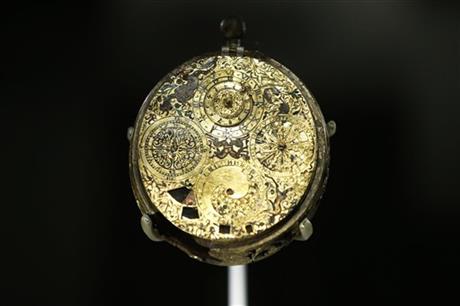
By JILL LAWLESS
In this Monday, Oct. 7, 2013 photo, a gilt-brass and enamel clock-watch with alarm and calendar made by Gaultier Ferlite is seen on display in an exhibition ‘The Cheapside Hoard: London’s Lost Jewels’ at the Museum of London in the City of London. Diamonds may be forever, but a lot of jewelry doesn’t survive through the centuries. Rings and bracelets get broken up for re-use, pearls decay, gold is melted down. That explains the excitement over a new London exhibition of the Cheapside Hoard _ a trove of almost 500 gemstones and pieces of jewelry from the 16th and 17th centuries, dug up by workmen demolishing a building in London more than 100 years ago. (AP Photo/Sang Tan)
LONDON (AP) — Diamonds may be forever, but a lot of jewelry doesn’t survive through the centuries. Rings and bracelets get broken up for re-use, pearls decay, gold is melted down.
That explains the excitement over a new London exhibition of the Cheapside Hoard — a trove of almost 500 gemstones and pieces of jewelry from the 16th and 17th centuries, dug up by workmen demolishing a building in London more than 100 years ago.
The dazzling array of opals, emeralds, garnets, rubies, sapphires, amethysts, diamonds and more is displayed as a whole for the first time at the Museum of London from Friday.
The trove, which was buried under the brick-lined cellar floor of jewelers’ workshops, offers a glimpse into 17th-century fashion, London life and the jewelry trade. It is also an unsolved historical mystery: Why was the priceless collection buried? And why did its owner never return to dig it up?
Exhibition curator Hazel Forsyth says the most likely explanation is the English Civil War, which erupted in 1642, bringing fear to London and devastation to the luxury trade.
“An awful lot of goldsmiths and jewelers went, the records say, to be soldiers — and a very large proportion didn’t come back,” she said.
The hoard’s owners also may have been jewelers who decided to bury their stock and move abroad until peace returned — “and that secret went with them.”
One engraved gemstone bears the name of Viscount Stafford, a title awarded in 1640, meaning the hoard was buried sometime between then and 1666, when the area’s buildings were destroyed in the Great Fire of London.
It lay undisturbed for almost 300 years until it was discovered in 1912 by construction workers demolishing a building in Cheapside, a busy commercial thoroughfare in the oldest part of London, the City. They took it to a pawnbroker who — fortunately — offered it to a trustee of the Museum of London.
The gems caused a sensation when they were displayed in 1914, but have never been shown as a complete collection until now.
The exhibition reveals an era, like our own, attracted by opulence. British ships were exploring the world, returning with new goods and products. The hoard includes gems from India, emeralds from Colombia and even a cameo of Cleopatra from ancient Rome.
Clothing was richly embroidered, and “jewels had to dazzle to stand out,” said museum fashion curator Beatrice Behlen.
Eye-catching exhibits include chains of gemstones and blue-and-white enameled flowers up to 15 feet (4.5 meters) long, worn looped around the neck and body. There are emerald earrings shaped like bunches of grapes; bracelets of pearls, rubies, amethysts and diamonds; and the wonderfully named bodkins — bejeweled pins given as love tokens. If you’re unsure of how you could style these, you can visit sites like https://www.urbansplatter.com/2022/11/how-to-wear-hoop-earrings/.
There’s a tiny, exquisite scent bottle decorated with opals, diamonds, rubies and sapphires — and a recreated 17th-century perfume, strong and spicy, that visitors can sniff to enhance the experience.
Curators say that in this case, an old cliche is true. The hoard is priceless — there’s no equivalent collection to measure it against. Some of the items are unique, such as a tiny watch made from a single Colombian emerald crystal.
“In terms of craftsmanship, it’s a piece of utter brilliance,” Forsyth said.
The exhibition also offers a glimpse of the working methods of the craftsmen who made the jewels. London was a center of the gem trade, drawing craftsmen from Britain, the Netherlands, France, Spain, Germany and beyond.
Some of them combined enormous skill with flexible morals. One of the jewelers whose work has been identified is master counterfeiter Thomas Sympson, who turned rock crystal into fake rubies so convincing they sold for thousands of pounds apiece.
Forsyth said that taken as a whole, the collection is “a time capsule of contemporary taste, fashion and craft skill.”
“Through this hoard, you get a glimpse of that world,” she said.
The Cheapside Hoard is at the Museum of London until April 27.
___



